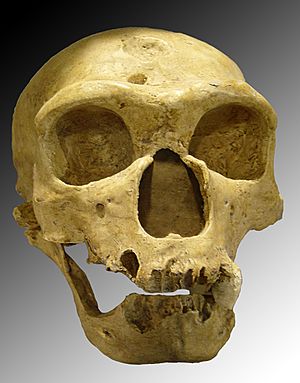Hominina facts for kids
Quick facts for kids HomininaTemporal range: Pliocene - present
|
|
|---|---|
 |
|
| Skull of Homo neanderthalensis | |
| Scientific classification | |
| Kingdom: | |
| Phylum: | |
| Class: | |
| Order: | |
| Superfamily: | |
| Family: | |
| Subfamily: | |
| Tribe: | |
| Subtribe: |
Hominina
|
| Genera | |
|
|
Hominina is a scientific group that includes humans and our closest extinct relatives. It's a special sub-group within the larger family of Hominidae, which includes all great apes. This group mainly focuses on apes who walked upright on two legs, like us.
Scientists use this term to classify different ancient species that are related to humans. If a scientist includes chimpanzees in the broader group called Hominini, then Hominina becomes a useful way to specifically group humans and our direct ancestors, like the Australopithecines. This group might include very old species like Sahelanthropus, which lived about six to eight million years ago.
Understanding Human Ancestors
When we talk about Homo, we mean the group that includes modern humans and our closest ancient relatives. The famous scientist Carl Linnaeus first named the group Homo for humans way back in the 1700s. At that time, he didn't think there would be any other species in this group.
But then, scientists discovered Neanderthals, who were the first new members added to the Homo group. This showed that the story of human evolution was much more complex.
What Makes a Species Homo?
Over the years, many fossils of early human-like species have been found. These discoveries help us understand how humans evolved. To classify a fossil as part of the Homo group, scientists look for two main things:
- Walking Upright: The species must show clear signs of being able to walk on two legs, just like humans do. This ability, called bipedalism, was inherited from even older ancestors like Australopithecus, who lived over four million years ago. Evidence of this can be seen in fossil footprints, like those found at Laetoli.
- Making Tools: The species must have used tools. The earliest known human tool culture began about 2.5 million years ago. Finding ancient tools alongside fossils helps scientists decide if a species belongs to the Homo group.

 In Spanish: Hominina para niños
In Spanish: Hominina para niños

